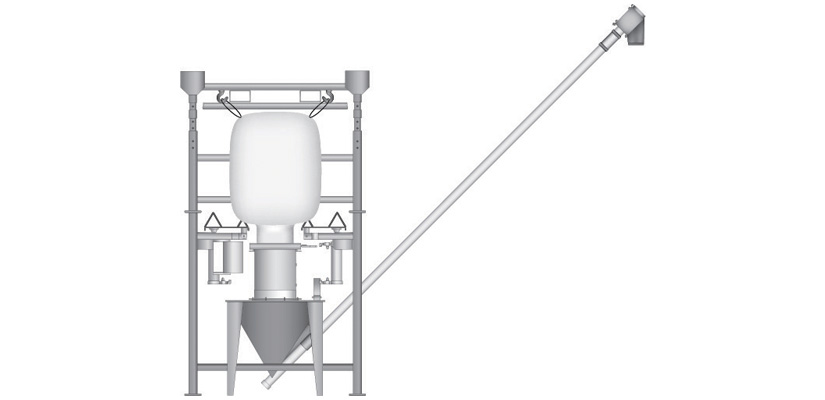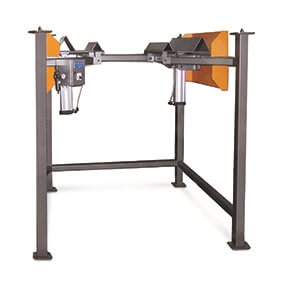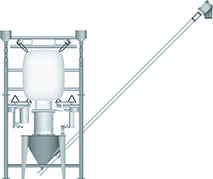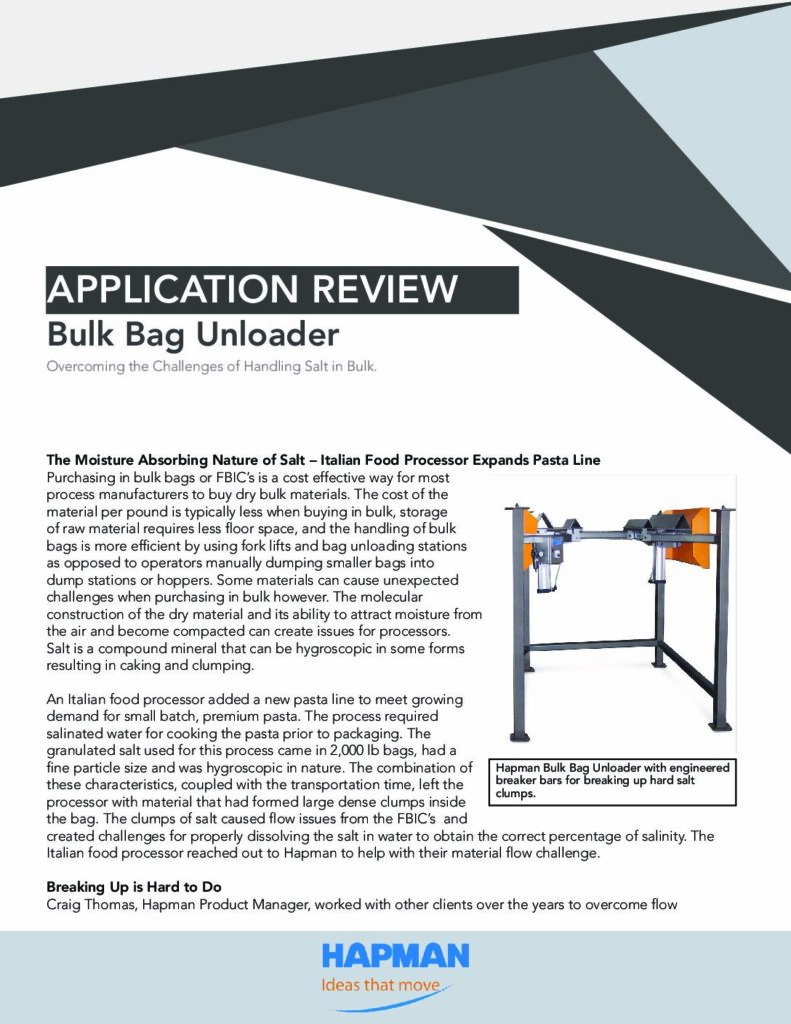
CHALLENGE
An Italian food processor added a new pasta line to meet growing demand for small batch, premium pasta. The granulated salt used for this process came in 2,000 lb bags, had a fine particle size and was hygroscopic in nature. The combination of these characteristics, coupled with the transportation time, left the processor with material that had formed large dense clumps inside the bag. The clumps of salt caused flow issues from the FIBC’s and created challenges for properly dissolving the salt in water to obtain the correct percentage of salinity. The Italian food processor reached out to Hapman to help with their material flow challenge.
INDUSTRY
Food
THE MOISTURE ABSORBING NATURE OF SALT – ITALIAN FOOD PROCESSOR EXPAND LINE
Purchasing in bulk bags or FIBC’s is a cost effective way for most process manufacturers to buy dry bulk materials. The cost of the material per pound is typically less when buying in bulk, storage of raw material requires less floor space, and the handling of bulk bags is more efficient by using fork lifts and bag unloading stations as opposed to operators manually dumping smaller bags into dump stations or hoppers. Some materials can cause unexpected challenges when purchasing in bulk however. The molecular construction of the dry material and its ability to attract moisture from the air and become compacted can create issues for processors. Salt is a compound mineral that can be hygroscopic in some forms resulting in caking and clumping. (http://en.wikipedia.org/wiki/Salt)
An Italian food processor added a new pasta line to meet growing demand for small batch, premium pasta. The process required salinated water for cooking the pasta prior to packaging. The granulated salt used for this process came in 2,000 lb bags, had a fine particle size and was hygroscopic in nature. The combination of these characteristics, coupled with the transportation time, left the processor with material that had formed large dense clumps inside the bag. The clumps of salt caused flow issues from the FIBC’s and created challenges for properly dissolving the salt in water to obtain the correct percentage of salinity. The Italian food processor reached out to Hapman to help with their material flow challenge.
BREAKING UP IS HARD TO DO
 Craig Thomas, Hapman Product Manager, worked with other clients over the years to overcome flow challenges from bulk bags due to clumping. Under most circumstances, offering a bulk bag unloader with air-operated bag massaging paddles would be the ideal answer to provide free flowing material when clumping inside the bag occurred. Unfortunately the salt lumps in this process were particularly hard and the fine particle of the granules made breaking up the clumps by simply massaging the bags nearly impossible. For this application, Mr. Thomas worked with the processor and the Hapman equipment engineering team to develop a unique series of breaker bars that could effectively and automatically break up the hard clumps of salt in the bag (see Figure 1 to right). The breaker bars were designed in parallel and at different heights. The bars, which were stainless steel formed triangular structures, had a engineered gap between them to assist in fracturing the large agglomerations. The breaker bars were mounted on the pneumatic agitator panels. When the panels were activated, the breaker bars were forced into the bag from both sides crushing any clumps in between. The paddles move out and in, each time breaking more clumps and allowing the free flowing material to leave the bag.
Craig Thomas, Hapman Product Manager, worked with other clients over the years to overcome flow challenges from bulk bags due to clumping. Under most circumstances, offering a bulk bag unloader with air-operated bag massaging paddles would be the ideal answer to provide free flowing material when clumping inside the bag occurred. Unfortunately the salt lumps in this process were particularly hard and the fine particle of the granules made breaking up the clumps by simply massaging the bags nearly impossible. For this application, Mr. Thomas worked with the processor and the Hapman equipment engineering team to develop a unique series of breaker bars that could effectively and automatically break up the hard clumps of salt in the bag (see Figure 1 to right). The breaker bars were designed in parallel and at different heights. The bars, which were stainless steel formed triangular structures, had a engineered gap between them to assist in fracturing the large agglomerations. The breaker bars were mounted on the pneumatic agitator panels. When the panels were activated, the breaker bars were forced into the bag from both sides crushing any clumps in between. The paddles move out and in, each time breaking more clumps and allowing the free flowing material to leave the bag.
CONVEYING TO THE NEXT LEVEL
 The Italian Food Processor expressed to Craig that in addition to breaking up the salt, the material needed to reach a mezzanine that was 12’ above ground level. Hapman supplied the processor with an integral hopper and Helix® Flexible Screw Conveyor (see Figure 2 to left). This complete equipment package unloaded the FIBC, collected the material in an integral hopper on the discharge of the bag, then automatically conveyed the salt up to the mezzanine where it was emptied into a reactor of boiling water to cook the pasta. The Helix was supplied with 304 stainless steel construction and a round wire auger. The bulk density of the material at 77 lbs/CF required the pull through of the round wire and eliminated concern of overload. The 2HP TEFC motor allowed for efficient batching operation and safe wash down. The right angle discharge allowed the conveyor to effectively release material under the low ceiling height. The Helix was engineered with a bolted cover and quick-release clean-out cap. The assembly mated to the bulk bag unloading access chamber to provide a sealed system and no loss of product.
The Italian Food Processor expressed to Craig that in addition to breaking up the salt, the material needed to reach a mezzanine that was 12’ above ground level. Hapman supplied the processor with an integral hopper and Helix® Flexible Screw Conveyor (see Figure 2 to left). This complete equipment package unloaded the FIBC, collected the material in an integral hopper on the discharge of the bag, then automatically conveyed the salt up to the mezzanine where it was emptied into a reactor of boiling water to cook the pasta. The Helix was supplied with 304 stainless steel construction and a round wire auger. The bulk density of the material at 77 lbs/CF required the pull through of the round wire and eliminated concern of overload. The 2HP TEFC motor allowed for efficient batching operation and safe wash down. The right angle discharge allowed the conveyor to effectively release material under the low ceiling height. The Helix was engineered with a bolted cover and quick-release clean-out cap. The assembly mated to the bulk bag unloading access chamber to provide a sealed system and no loss of product.
ENGINEERED EQUIPMENT – PROCESS OPTIMIZATION
The food processor installed the Bulk Bag Unloader with breaker bars and integral Helix Flexible Screw Conveyor on the new premium pasta line. The unloader was one of the key components to making the new line a success. The Italian food processor realized cost and time savings by making the investment in the equipment. Without the ability to reliably and consistently break up the large, hard salt clumps the percentage of salinated water could not be maintained at a consistent rate, causing quality concerns. In addition, the processor would have faced significant salt loss due to the inability to effectively empty the bags. The collaboration with Hapman helped this processor successfully launch the new, high-quality product consumers expected.
